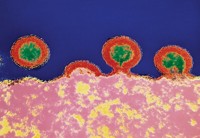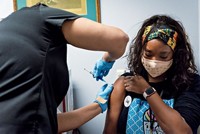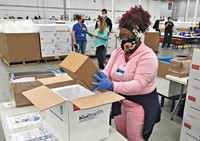Advertisement
Grab your lab coat. Let's get started
Welcome!
Welcome!
Create an account below to get 6 C&EN articles per month, receive newsletters and more - all free.
It seems this is your first time logging in online. Please enter the following information to continue.
As an ACS member you automatically get access to this site. All we need is few more details to create your reading experience.
Not you? Sign in with a different account.
Not you? Sign in with a different account.
ERROR 1
ERROR 1
ERROR 2
ERROR 2
ERROR 2
ERROR 2
ERROR 2
Password and Confirm password must match.
If you have an ACS member number, please enter it here so we can link this account to your membership. (optional)
ERROR 2
ACS values your privacy. By submitting your information, you are gaining access to C&EN and subscribing to our weekly newsletter. We use the information you provide to make your reading experience better, and we will never sell your data to third party members.
Vaccines
Covid-19
Novavax and J&J COVID-19 vaccines are effective, but the virus variant from South Africa poses problems
Preliminary results from advanced studies of the vaccines are met with excitement as well as trepidation about emerging virus variants
by Ryan Cross
January 29, 2021

Two more COVID-19 vaccine developers released preliminary results from ongoing clinical trials suggesting that their shots are safe and effective.
On Jan. 28, Novavax said two shots of its vaccine, administered 3 weeks apart, were 89.3% effective at preventing mild, moderate, or severe COVID-19 in the UK. And on Jan. 29, Johnson & Johnson announced that a single shot of its vaccine, tested in several countries, was on average 66% effective at preventing moderate to severe COVID-19.
Doctors and researchers were largely encouraged by the results. The Novavax vaccine seems to be about as effective as the Moderna and Pfizer-BioNTech vaccines authorized in the US, which are about 95% effective. Scientists even welcomed the less-effective J&J vaccine, which requires only a single shot, rather than the two shots required for the other vaccine frontrunners.
“It is an exciting thing, although we still need to see published data to pick it apart properly,” says Lynda Coughlan, a virologist at University of Maryland School of Medicine.
But the news wasn’t entirely positive. Both vaccines were less effective in trials conducted in South Africa, where the so-called B.1.351 variant has recently become the predominant form of SARS-CoV-2 in circulation. “The vaccines didn’t protect well against that variant, and that is something we have to worry about,” says Hildegund C.J. Ertl, a vaccine scientist at the Wistar Institute.
The B.1.351 variant was discovered in South Africa in December and first detected in the US on Jan. 28—the same day that Novavax announced its trial results. That variant contains several mutations in its spike protein. The virus uses that protein to infect human cells, and all of the leading COVID-19 vaccines are based on synthetic forms of the protein that trigger an immune response. Mutations have arisen in the spike protein before, but B.1.351 appears to be the first variant documented to significantly reduce the effectiveness of the vaccines.
The Novavax shots were only 60% effective in South Africa, and the J&J vaccine only 57% effective in that country. Both companies found that more than 90% of the people who tested positive for COVID-19 and had their virus samples sequenced were infected with the B.1.351 variant, supporting the growing concern that some new variants of the virus could hinder the effectiveness of the vaccines.
“The reduced ability to neutralize the South African strain is a concern,” says David Hirschwerk, an infectious disease specialist at Northwell Health. “But even if a vaccine is not fully protective it may still mean the difference between developing severe illness or having a more mild course of the disease,” he adds. “I think people should really take the first vaccine that is offered to them.”
Like most companies, Novavax and J&J announced their vaccine results via press releases and conference calls, promising to submit data to peer-reviewed journals in the future. J&J says it will submit its vaccine for Emergency Use Authorization (EUA) to the US Food and Drug Administration in early February, suggesting that it could be the third authorized COVID-19 vaccine in the US. The Moderna and Pfizer-BioNTech vaccines earned EUAs in December.
Novavax said it began a rolling submission of its data to regulatory authorities in the UK but did not specify the timing of an EUA submission in the US.
The J&J shot is made with adenoviral vector vaccine technology that uses a weakened common cold virus to deliver a single coronavirus gene into human cells. That gene encodes instructions for making the SARS-CoV-2 spike protein. AstraZeneca’s vaccine, authorized in the UK but still undergoing testing in the US, is also an adenoviral vector vaccine.
The Novavax shot contains the spike proteins themselves, held together in a detergent micelle and mixed with molecules called adjuvants that help stimulate the innate immune system. Novavax is the first company to disclose preliminary results from an advanced clinical trial of a protein-based vaccine, an established method of developing vaccines first approved 40 years ago.
Novavax presented preliminary data from two clinical trials. In a Phase 3 study of more than 15,000 adults in the UK, 6 people who got the vaccine tested positive for COVID-19, compared to 56 people who got placebo shots. One person, who was in the placebo group, developed severe disease. More than half of the people who were infected in the UK trial had a highly contagious variant of the virus called B.1.1.7 that was first detected in the UK in December. The vaccine appeared to be 95.6% effective against the original virus strain and 85.6% effective against B.1.1.7.
In a separate Phase 2b study of 4,400 adults in South Africa, the Novavax vaccine was 60% effective when excluding people who were HIV positive, and 49.4% effective when those people were included in the analysis. Novavax has also enrolled nearly 17,000 people in a planned 30,000-person Phase 3 trial in the US and Mexico.
J&J’s Phase 3 trial included nearly 44,000 adults. Four weeks after vaccination, the shot was 72% effective at preventing moderate to severe COVID-19 in the US, 66% effective in Latin America—including trials in Argentina, Brazil, Chile, Colombia, Mexico, and Peru—and 57% effective in South Africa.
“I was underwhelmed,” Ertl says of the Phase 3 data. “The efficacy is not where I’d like to see it. But they might fix that with a booster shot.” Still, she is encouraged by another detail in the J&J announcement—that its vaccine provided “complete protection against COVID-related hospitalization and death,” with no reported cases 4 weeks after vaccination. The shot was 85% effective at preventing all severe disease after 4 weeks as well.
“Really what we want more than anything is to help people avoid developing severe disease,” Hirschwerk says. “If vaccinated people get COVID, but they are less likely to develop severe COVID and become hospitalized, then significant value remains.” And even if some vaccinated people still get sick and need to go to the hospital, the vaccine might keep them from requiring intensive care, where the risk of death is greatest, he adds. “So the lack of 100% effectiveness really has to be framed and viewed through that lens.”
Ertl says the companies may have to consider revising the vaccines to match emerging variants of the virus. Moderna and Novavax have already announced plans to do so. “And that is absolutely prudent,” she says. Moderna said it is working on a vaccine candidate based on the B.1.351 variant that it will test as a booster shot. And Novavax is making new vaccine candidates to use either as a booster shot for its current vaccine, or as a bivalent vaccine, which would combine both versions in one shot.
The J&J and Novavax shots have the advantage of being easier to distribute and store than the Moderna and Pfizer-BioNTech vaccines, which have to be kept in freezers. J&J says its vaccine may remain stable for up to three months at 2-8°C, and Novavax says its vaccine can be shipped and stored at the same temperature. “From a logistics standpoint that makes a huge difference,” Hirschwerk says.
Coughlan agrees, adding that the advantage of J&J’s vaccine being a single dose cannot be overlooked. “For a single shot to have very rapid protection—and importantly, protection from severe illness, hospitalization, and death—is very, very good news,” she says.





Join the conversation
Contact the reporter
Submit a Letter to the Editor for publication
Engage with us on Twitter